#Jamea Richmond-Edwards
Explore tagged Tumblr posts
Photo
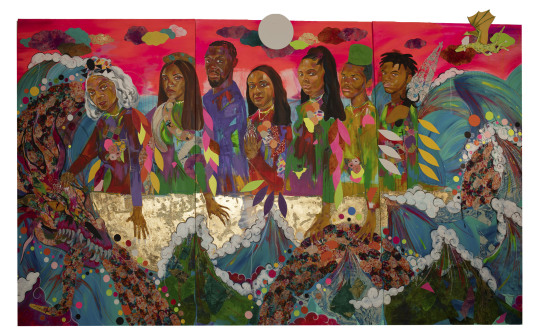

Jamea Richmond-Edwards is an artist from Detroit, Michigan who, after two decades away, recently returned to her home city.
The story of her mother’s family being displaced and traveling across four Southern states due to tragic floods and tornadoes is told in an epic multimedia installation, titled “This Water Runs Deep,” composed of a monumental painting and a sound sculpture of jazz instrumentation in A Movement in Every Direction: Legacies of the Great Migration.
See this work that blends mythological imagery and the artist’s family legacy in A Movement in Every Direction: Legacies of the Great Migration through June 25.
📷 Jamea Richmond-Edwards (born Detroit, Michigan, 1982; based in Detroit, Michigan). This Water Runs Deep, 2022. Mixed media on canvas with sound: 2 min., 18 sec., 96 in. × 15 ft. (243.8 × 457.2 cm). Courtesy of the artist and Kravets Wehby Gallery → Jamea Richmond-Edwards
#Brooklyn Museum#GreatMigrationBkM#brooklyn#museum#art#exhibition#New York City#painting#the great migration#multimedia#artist#Jamea Richmond-Edwards
47 notes
·
View notes
Text
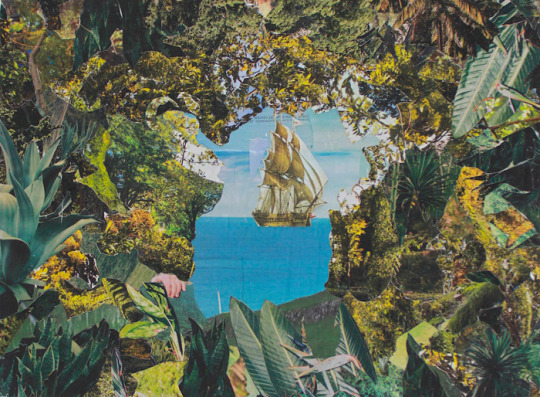
COLLAGE ON VIEW
Mulitplicity
Blackness in Contemporary American Collage at the Museum of Fine Arts, Houston in Houston, Texas, USA through 12 May 2024. Organized by the Frist Art Museum in Nashville, Tennessee, “Multiplicity” is the first major museum exhibition devoted to this rich yet understudied subject. Featuring some 80 collage and collage-informed works, the exhibition explores the breadth and complexity of Black identity and experiences in the United States. With an intergenerational group of 52 living artists, “Multiplicity” examines how concepts such as cultural hybridity, notions of beauty, gender fluidity, and historical memory are expressed in the practice of collage. By assembling pieces of paper, fabric, and other often-salvaged or repurposed materials, the artists in this exhibition create unified compositions that express the endless possibilities of Black-constructed narratives despite our fragmented society. The artists range from established luminaries to early- and mid-career figures, including Mark Bradford, Lauren Halsey, Rashid Johnson, Kerry James Marshall, Wangechi Mutu, Jamea Richmond-Edwards, Deborah Roberts, Tschabalala Self, Lorna Simpson, Devan Shimoyama, and Mickalene Thomas. Read More
*****************************
Kolaj Magazine, a full color, print magazine, exists to show how the world of collage is rich, layered, and thick with complexity. By remixing history and culture, collage artists forge new thinking. To understand collage is to reshape one's thinking of art history and redefine the canon of visual culture that informs the present.
SUBSCRIBE | CURRENT ISSUE | GET A COPY
SIGN UP TO GET EMAILS
7 notes
·
View notes
Text
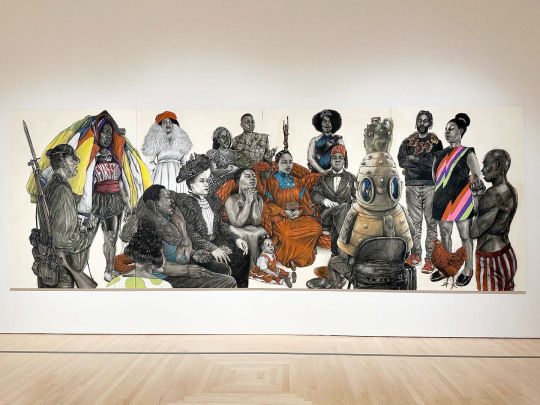
(image above- Robert Pruitt, "A Song for Travelers")
Brooklyn Museum's exhibition, A Movement in Every Direction: Legacies of the Great Migration, is an opportunity to learn about an important period of American history, and see it interpreted through the eyes of twelve contemporary artists.
From the museum's website-
Between 1915 and 1970, in the wake of racial terror during the post-Reconstruction period, millions of Black Americans fled from their homes to other areas within the South and to other parts of the country. This remarkable movement of people, known as the Great Migration, caused a radical shift in the demographic, economic, and sociopolitical makeup of the United States. A Movement in Every Direction: Legacies of the Great Migration brings together twelve contemporary artists to consider the complex impact of this period on their lives, as well as on social and cultural life, with newly commissioned works ranging from large-scale installation, immersive film, and tapestry to photography, painting, and mixed media. Featured artists are Akea Brionne, Mark Bradford, Zoë Charlton, Larry W. Cook, Torkwase Dyson, Theaster Gates Jr., Allison Janae Hamilton, Leslie Hewitt, Steffani Jemison, Robert Pruitt, Jamea Richmond-Edwards, and Carrie Mae Weems. A Movement in Every Direction presents a departure from traditional accounts of the Great Migration, which are often understood through a lens of trauma, and reconceptualizes them through stories of self-possession, self-determination, and self-examination. While the South did lose generations of courageous, creative, and productive Black Americans due to racial and social inequities, the exhibition expands the narrative by introducing people who stayed in, or returned to, the region during this time. Additionally, the Brooklyn Museum’s presentation centers Brooklyn as another important site in the Great Migration, highlighting historical and contemporary census data about the borough’s migration patterns. Visitors are encouraged to share their own personal and familial stories of migration through an oral history “pod” available in the exhibition galleries.
About Robert Pruitt's work, pictured above, from the museum's wall information plaque-
“A Song for Travelers” celebrates the individual and Black collective experiences that have shaped the histories of rural East Texas and Houston's Third, Fourth, and Fifth Wards. In this drawing-based on an early 1970’s photograph of a reunion of the artist's family in Dobbin, Texas -sixteen people gather around a seated central figure about to embark on a journey. During the creation of this work, the masked traveler became a stand-in for Pruitt, who had recently left his hometown of Houston.
Pruitt often draws inspiration from his and others' family photographs while examining historical events that have impacted Houston's Black communities. Wearing costumes and adorned with items that reference various aspects of Black culture found in schools, social clubs, and religious spaces, the figures in the work reflect the numerous networks that remained and flourished in the South. Merging the Great Migration period with the present, Pruitt centers the Black neighborhoods across the southern region that served as safe havens and rich sites of cultural expression for migrants during the twentieth century. This link extends to today as many Black Americans leave the northern and western cities that once attracted their elders and return to the South.
Allison Janae Hamilton's A House Called Florida, below, takes the viewer on a journey through part of northern Florida's natural beauty.

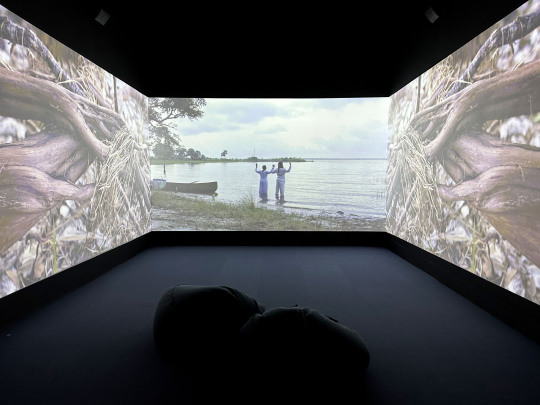

From the museum's information plaque about the video installation-
Allison Janae Hamilton produced the three-channel film installation A House Called Florida in her hometown region of northern Florida. The breathtaking landscapes of Apalachicola Bay and the swampy Blackwater Lakes of Florida's Big Bend frame musicians, dancers, motorists, a Victorian house, and a slow resounding rhythm. The artist references French Argentinian writer Julio Cortázar's 1946 short story "Casa Tomada." ("House Taken Over") about ghosts that slowly take over a home and eventually push out its owners, room by room. Hamilton echoes the story's theme of displacement with two regally dressed, spirit-like protagonists who move about the house engaging in mark-making and ritual performances. Hamilton's film pays tribute to the Black Floridians who remained in the Red Hills and the Forgotten Coast regions, despite the racial violence and environmental precariousness they faced throughout the nineteenth and twentieth centuries.
Carrie Mae Weems' personal and moving contribution is in two parts- a series of photographs and a unique digital video installation.


The museum's description of the work-
Carrie Mae Weems explores a painful family story: the disappearance of her grandfather Frank Weems, a tenant farmer and union activist who was attacked by a white mob in Earle Arkansas, in 1936. Presumed dead, he narrowly escaped and made his way to Chicago on foot, never again reuniting with his family. Frank Weems may have followed the North Star to Chicago. Weems's series of seven prints, The North Star, makes an apt metaphor for Frank's life. In Leave! Leave Now! Weems conjures the figure of her grandfather with a Pepper's Ghost, a late nineteenth-century form of illusion first used in theater. By weaving historical events with fragmented family stories, photographs, poetry, music, and interviews, the artist reveals the tragedy of her grandfather's disappearance and the aftermath.
This exhibition will close on Sunday, June 25th, 2023.
#brooklyn museum#carrie mae weems#robert pruitt#allison janae hamilton#art shows#art#video art#painting#the great migration#american history#sculpture#art installation#drawing#brooklyn art shows#nyc art shows
3 notes
·
View notes
Text
Curated Portfolio FD2
Gesture


2. Contour


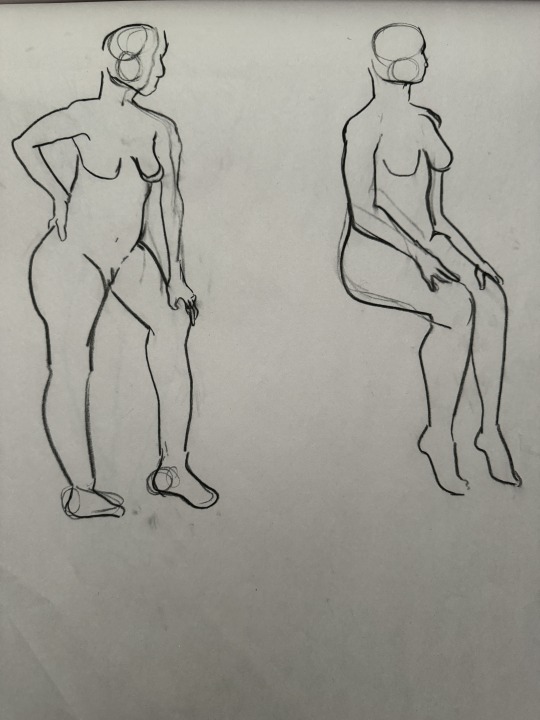
3. Blind Contour
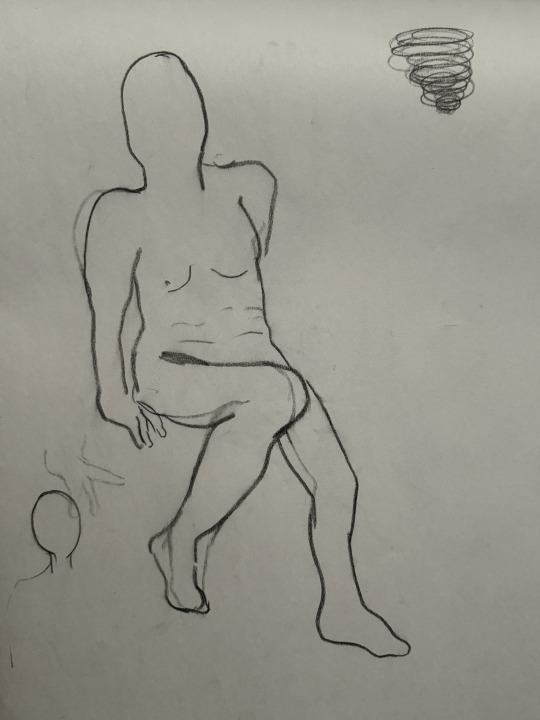
4. 5 Minute Pose



5. Eggs

6. Blind Hand Contour
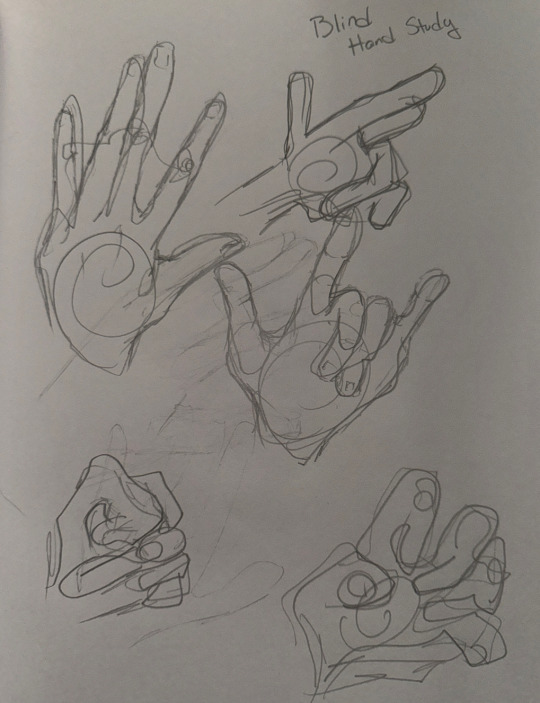
7. Skull Study

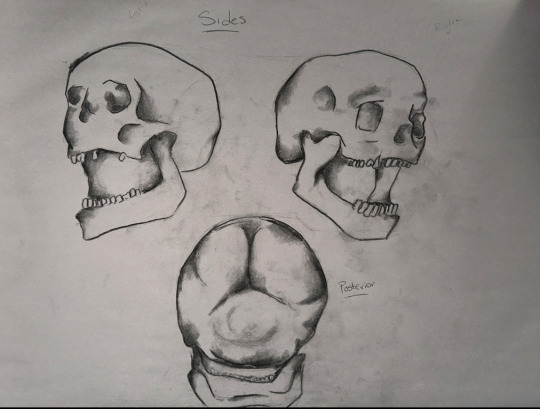
8. Spine Study

9. Skeleton Study in Class

10. Peer Portrait
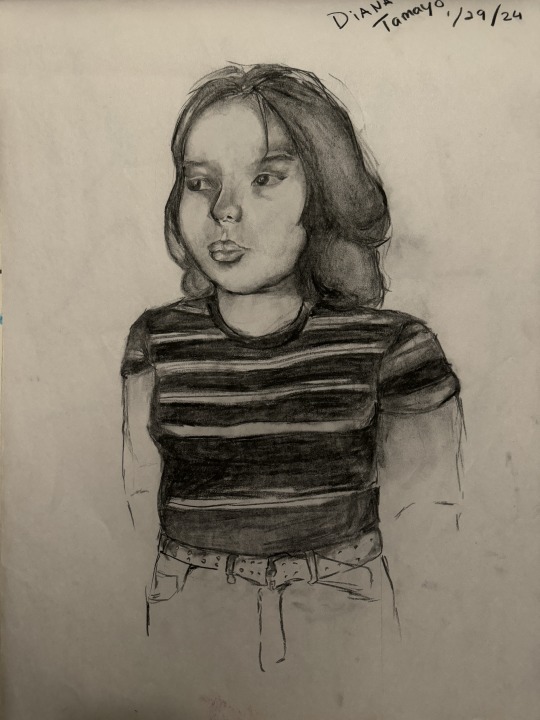
11. Self Portrait 3 views

12. Perspective study 3 Figure Color

13. Figure Color Assignment (last day painting in class)

14. Museum Inspired (+notes)
After visiting the MoCA, I was overcome with so much inspiration after seeing Jamea Richmond-Edwards: "Ancient Future" and her use of acrylic to create maximalist paintings. The painting "Lullaby for a Shooting Star" features a dragon adorned by various shapes and color variations that inspired my painting "Tiger Lilies." It was fun experimenting with vivid colors and one day I aspire to add fabrics and textures to my paintings.


15. Mid-Term
The process of making a head-to-toe self portrait of myself was a challenging one. Looking at myself in the mirror as I examined my bone structure, the way my eyes are hooded, eyebrows are uneven and slightly crooked nose towards the bridge made me fall in love with myself through the understanding that every human is built uniquely so. I decided to incorporate my cat in this portrait since I strongly believe anyone that truly knows me, knows my cat. The flowers in the background represent my beginnings in art, since I was little I would find an interest i the way flower petals fold and their intricate insides. Im wearing a black dress, I own my fair share of dresses but rarely seen wearing them thereforeI wanted to portray myself as the femme figure I rarely show. Lastly, my cat socks, which further explains my cat-obsessed brain, I carry a piece of Nina, my cat, everywhere I go.
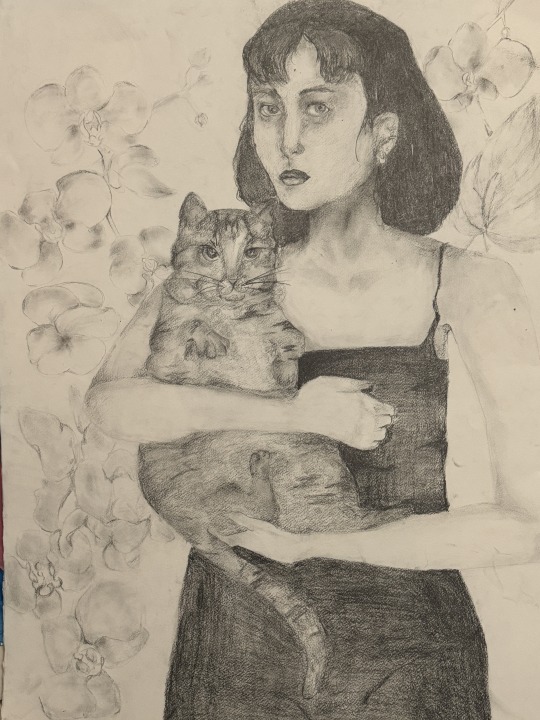


16. Final
Exploring acrylics for the first time, I incorporated bright colors in this painting to provide a warm, at-home-feeling of intimacy felt by two people living with their cats. There is a black cat in the background interacting with the brown skin figure, an orange cat in a closer distance resting on the floor next to a lighter-skin toned figure who's sitting on a chair replicating the one from my home which I often sit on drinking my morning coffee as my cat takes her first nap of the day. Lastly, my last figure is a gray tabby cat with yellow-green toned eyes which represents my own cat, the way the feline tilts its head reminds me of Nina's (my cat) child-like wonder and the "curious cat" stereotype. My overall experience with this piece was to push myself to try new things and be bale to bring familiarity towards strange territory.
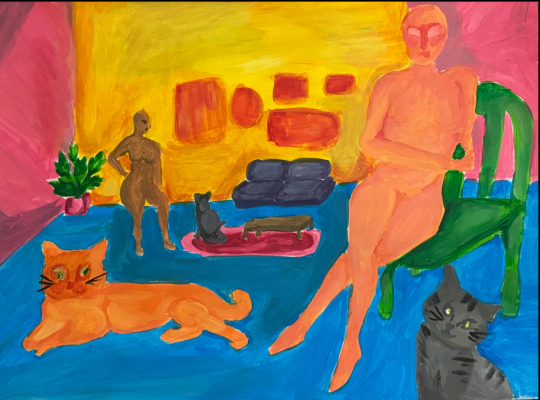
Artist Statement
A material I adored throughout this semester has been the soft charcoal vines, I had a lot of fun being able to create shapes and modify them without the commitment of strict line-work. My favorite assignment had got to be the self portrait because I had never been challenged enough to pushed through a life-sized drawing of myself. I believed to have grown as an artist and no longer fear big projects. Some obstacles I faced this semester was relying on reality rather than letting my brain wonder on the shape of the head or legs. I was able to overcome this problem through practicing in my sketchbook the devision of the human symmetry and being able to recognize all sections in which the body is divided into.
0 notes
Text



ART 1330C FD2, ART1300C Drawing, and ART1203C 3D MOCA Sketches and overall notes Notes: What captivated me most about the artworks was the use of framing to place emphasis on different elements of an artwork. For example the bleak dark landscape of Lorraine O'Grady's The Fir Palm puts emphasis on the otherwise more defined tree, which captivated me at first. Likewise on Jamea Richmond-Edwards' Mother and Child, it is composed in such a way the mother takes focus while the child is off to the side of the composition and that seemed like an interesting artistic choice. Sculpture-wise, the use of wood had me in shock for the most part. It never occurred to me the use of wood to craft a human hand would create such a sense of connection with nature. Likewise, the use of it to craft Juan Francisco Elso's La ceiba y La palma created this sense of dread when I looked at the piece no other tree out in the real world ever evoked in me. The explosions of color in Jamea Richmon-Edwards' artwork creates a sense of culture and wonder like no other. The bleakness of certain artworks like Albert Chong's Natural Mystic create a sense of bleak despair that starkly contrasts Jamea's works. The use of color in the works of the museum left an impression on me. I am connected to the message of works such as Juan Francisco Elso's Belkis Ayon & Angel Ramirez because of the origins these people have in Havana, where part of my family originates from.
0 notes
Text
Museum of Contemporary Art North Miami
I enjoyed Jamea Richmond Edwards' Ancient Future exhibition. Her use of vibrant colors and various medians drew me in. I like how there is no white space or emptiness. The use of fabric, paper, ink, and even stuffed animals. Every inch of the canvas is unique and colorful. Jamea Richmond Edwards's Ancient Future uses symbolism and imagination to create visionary works. Her work transports you to a vibrant universe that combines elements of the past, present, and her imagined future. Her world combines black culture, historical mythology, and imagination.
My sketch inspired by Jamea’s Ancient Future painting
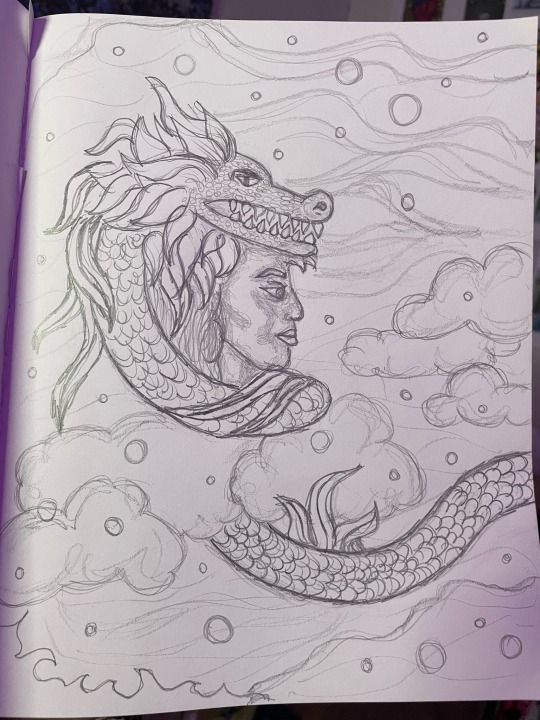
0 notes
Photo

Jamea Richmond-Edwards’ Ancient Future « Adafruit Industries – Makers, hackers, artists, designers and engineers!
0 notes
Text

#this water runs deep#a movement in every direction#art#mississippi museum of art#imani khayyam#jamea richmond-edwards
0 notes
Photo

Jamea Richmond-Edwards Levitate 2016 The Southern
5 notes
·
View notes
Text






Jamea Richmond-Edwards.
Exceptionally incredible paintings from Detroit, Michigan artist Jamea Ricmond-Edwards that explore - through an imaginative form of magical realism - her childhood in the AIDS and crack epidemic of 1980s America and their lasting impact on Black and Indigenous American communities across the United States.

THE SUPERSONIC ART SHOP | FOLLOW ON INSTAGRAM
62 notes
·
View notes
Photo

Jamea Richmond Edwards - Wings not meant to fly - 2016
8 notes
·
View notes
Photo
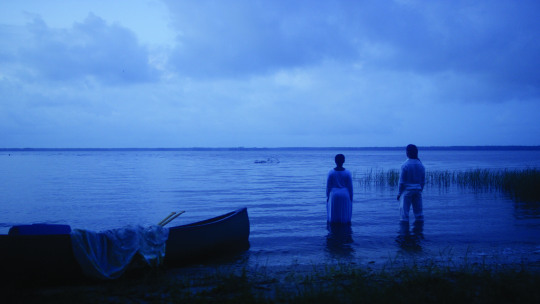
Coming Soon… A Movement in Every Direction: Legacies of the Great Migration. 📍
In this exhibition, twelve influential and emerging artists reflect on the Great Migration period (1915–70), during which millions of Black Americans fled from their homes to other areas of the South and across the country in the wake of racial terror. Large-scale installation, painting, immersive film, tapestry, mixed media, and photography depict the artists’ experience with this mass movement, as well as its continuing impact on their lives and on social and cultural life in the United States.
We look forward to sharing with you the work of Akea Brionne, Mark Bradford, Zoë Charlton, Larry W. Cook, Torkwase Dyson, Theaster Gates Jr., Allison Janae Hamilton, Leslie Hewitt, Steffani Jemison, Robert Pruitt, Jamea Richmond-Edwards, and Carrie Mae Weems.
📷 Allison Janae Hamilton (born Lexington, Kentucky, 1984; based in New York, New York). Still from “A House Called Florida,” 2022. Three-channel film installation (color, sound): 34 min., 46 sec. Courtesy of the artist and Marianne Boesky Gallery, New York and Aspen
#Brooklyn Museum#brooklyn#museum#art#exhibition#artist#painting#film#photography#installation#New York City#nyc#great migration#GreatMigrationBkM
29 notes
·
View notes
Photo

Emersed
Jamea Richmond-Edwards, American Artist
44 notes
·
View notes
Note
Is there a common color scheme in the books you buy?
That’s an interesting and unexpected question. A lot of the books I have right now have artwork by Black people as the cover. There is no particular color scheme, but the books I look for and read are mostly by Black authors, and those Black authors tend to-no always mind you-have artwork by Black people on their covers. Let me pull out some covers of books I have right now that exemplify this:

This cover is by the Black visual artist Tschabalala Self. It’s called Get It.

This cover is by the Black visual artist Kenyatta A.C Hinkle and it’s called Now There Are Three Ways to Get This Done: Your Way, Their Way or My Way.

This cover is by Jamea Richmond-Edwards. It’s named Wings No Meant To Fly.
So yeah. A lot of what I read is nonfiction (and a lot, if not the totality of this nonfiction comes from Black scholars) and situates itself at the intersection of Black feminism, Black studies and Black queer theory. So that explains why the covers are by Black artists, mostly once again by Black female artists.
5 notes
·
View notes
Text








Museum Visit
I went to MoCA on Sat 3/16 and had the pleasure to witness the current exhibition Elso’s “Por América” and Jamea Richmond-Edwards: “Ancient Future.” Had the best time ever !
0 notes
Text

Drawing Class ART1300C Drawing (Narrative, inspired by Jamea Richmond-Edwards and her incorporation of multiple abstract figures amongst cultural/nonabstract symbolism)
0 notes